Painting & drawing blog
A LOOK AT WATER-MIXABLE OIL PAINT
In this post I’m going to talk about my experience of trying out the new water soluble oil paints, and in particular Winsor & Newton’s popular ‘Artisan’ range. I’ll discuss how you work with these new paints differently to conventional oils, and the difference between ranges marketed for beginners and those aimed at professional painters. I’ll compare the Artisan paints to water soluble ranges made by Holbein, Royal Talens, Grumbacher and Daniel Smith paints. There are no paid links or affiliations in this article, just my own findings.
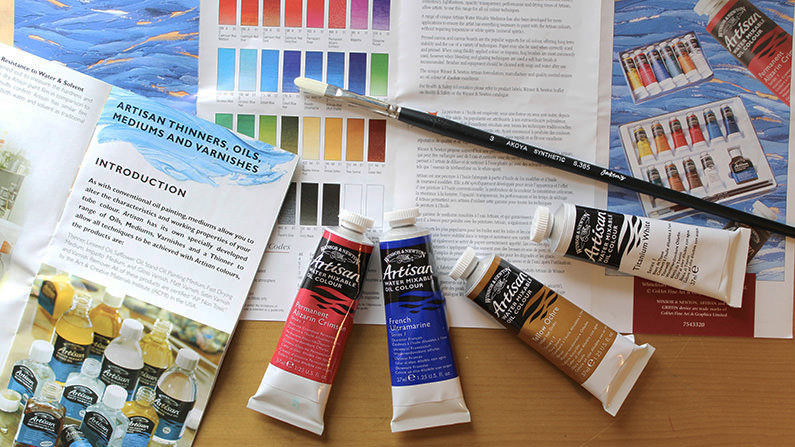
British company Winsor & Newton rather dominates the art supplies market in the UK. They were one of the first companies to develop water soluble oils, and Artisan was initially the only range that was easily obtainable here. These days many paint companies sell water-mixable ranges. Daler-Rowney make a water-soluble version of their student grade Georgian range which has 40 colours, and the large online retailer Jacksons produce their own beginners’ range of 48 colours called Aqua Oils.
Amongst the ranges marketed as ‘professional’ grade paints, Japanese company Holbein make a large range called Duo Aqua which has 100 colours. The Dutch manufacturer Royal Talens make a range called Cobra Artists that comes in 70 shades (they also make a student grade range called Cobra Study) whilst the German company Lukas’s Berlin range has just 40 colours. There are two popular American brands: Daniel Smith’s Water Soluble Oil Paint and Grumbacher’s Max range which have 43 and 59 colours respectively.
How they actually work
There are a number of names for water-mixable oil paints and you’ll also see them referred to interchangeably as ‘water-soluble’ or ‘water-miscible’ oils or ‘WMOs’, or as ‘aqua oils’. They are sometimes marketed as ‘solvent-free paints’ which is somewhat misleading because conventional oils don’t contain solvents either, although solvents are often used to dilute or clean up after them.
The principle of WMOs is that they consist – just like regular oil paints – of a quantity of pigment suspended within an oil medium such as linseed oil, which serves to bind the pigment and set the paint as it dries by a process of oxidisation. Water-mixable oils don’t actually contain any water within the tube. Instead with Artisan paints the linseed oil binder has been altered by modifying a single molecule so that it can bind loosely to water molecules and form an emulsion with them. The paint dries in two stages: firstly any water you may have added to them yourself evaporates, and then the oil slowly oxidixes and ‘cures’ just like conventional oil paint.
Not every make of water-mixable oils uses the same method to create a paint that can bond with water, and therefore different brands will vary in terms of how they handle. Whilst most ranges work by modifying the oil binder just like the Artisan paints, others use additives to cause the oil to form a solution with water. For example Holbein’s WMO range is identical to their regular oil paints, but with the addition of a ‘surfectant’ which lowers the surface tension of the oil to make it soluble in water. Grumbacher’s range uses an ’emulsifying additive’ to achieve the same end.
What sort of quality are Artisan paints?
The difficulty in using Artisan paints to assess water-mixable oils in general, is that it’s hard to establish exactly what quality of paint this range represents. Different paint ranges vary hugely in terms of both the ratio and the quality of pigments in their tubes. Thus beginner or ‘student’ ranges which tend to have a lower pigment content with cheaper pigments bulked out with fillers, will look and handle differently to a top paint range designed for professionals. The Artisan felt slightly thin and oily to me in a similarly to a student grade paint, but is this to do with the water-miscible aspect or the quality of the paint mixture?
Winsor & Newton state that: “… Artisan could be considered an artists’ grade, however, the inclusions of hues and the shorter palette [colors available] means that Artisan can in fact be considered somewhere between an artists’ and students’ grade and is therefore priced accordingly.”
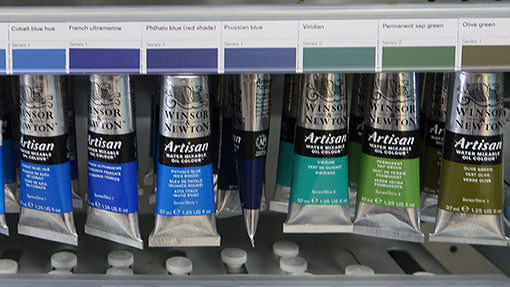
It’s true that the Artisan range contains only 40 colours and that having such a small range is something generally associated with a student grade paint, although it should also be noted that the water-mixable range by Daniel Smith – a top quality paint manufacturer – has only 43 colours. Artisan is an unusual range in that it provides buyers with a choice of both some more expensive, ‘single pigment’ colours and also their ‘hue’ alternatives (a ‘hue colour’ is a less expensive approximation of a traditional or historical colour, made by blending less expensive pigments to match the original shade). So for example the Artisan range contains both a true ‘Cadmium Red Medium’ and a ‘Cadmium Red Hue’, a true ‘Cobalt Blue’ and a ‘Cobalt Blue Hue’.
I was pretty suspicious about the quality of even these true cadmiums and cobalts when I noticed that they only had a ‘series 2’ brice bracket designation. Paint companies divide their colours into price bands called ‘series numbers’, depending on the cost of producing the pigments used to make them. The scale runs from series 1 – the cheapest price bracket – up to series 5. In most professional ranges, costly cadmiums and cobalts are usually designated as series 4. In the Artisan range they are only series 2, which makes me suspect that the tube contains a smaller pigment ratio than a professional range and is bulked out with fillers, in order to bring the cost of the paint down and reduce the price variability between different colours in the range.
Once you discount Artisan’s seven ‘hue’ colour alternatives, the tally of colours is small and the choice is pretty limited. Twenty-three of the colours are made from a single pigment each. ‘Single pigment’ colours tend to give a greater purity and intensity than ‘convenience colours’ like hues which are mixed from a number of different pigments. Therefore the percentage of single pigment colours in a range is a fairly good guide to the quality of the range overall. Artisan’s single pigment percentage isn’t terrible but it’s not that impressive either, especially as quite a few of the single pigment shades are earth colours which are cheap to produce.
Compared to Winsor & Newton’s regular professional oil colour range, the Artisan paints felt not only slightly thinner and oilier, but the colour also appeared a little less saturated. This could be because they have a lower pigment content, but it could also be to do with the water-mixable aspect, because it’s commonly reported that WMO paints don’t ‘spread’ quite as easily and don’t go as quite as far as conventional oils. It’s hard to tell.
Because Artisan were one of the first water-soluble ranges on the market, my instinct is that Winsor & Newton conceived them as a product which would appeal to the beginner or amateur painter and also to the student market rather than to professional or very experienced painters, and that therefore they were formulated to a reasonable quality, but not to the same level as a professional quality range. This is reflected in the relatively low price of the paints, and also the initially rather garish tube design that looked very much like a student range, although I’ve noticed that the packaging has now been redesigned to look more like Winsor & Newton’s professional grade paint products.
FIRST IMPRESSIONS OF USING WATER MIXABLE PAINT:
Mixing with water
When you’re so used to traditional oil painting, an oil paint that dissolved in water seemed very strange indeed, and rather exciting. My first realisation however was that water-soluble oils were not quite as easy to clean as I’d imagined. The paint did seem to rinse off my brushes fairly easily, just by running them under water. However paint stains on brush handles and my own hands required soap and some scrubbing, and I learned not to clean up in a white sink unless I wanted to resort to white spirit to get the paint stains off. This wasn’t unique to Artisan but was something I noticed with some other brands that I tried too. Using an olive oil-based soap rather than regular hand soap helped a bit.
One of the colours that came in my boxed Artisan set – the ‘Pthalo Green’ shade – appeared to have something wrong with it because it really did not come off with soap and water. In fact it barely seemed to mix with water at all and only white spirit got it off my brush and hands. Pthalo pigments are very intense and staining but I really feel like this must have been a dud batch and I hope that Winsor & Newton have got this sorted out since I bought this set which admittedly was quite some time ago – having seen the box on sale I’d bought it out of curiosity and then it sat in a drawer for a couple of years before I tried the paints out.
The effect on your brushes
The second thing I discovered was that traditional oil painting brushes made from hog hairs aren’t great for water-mixable oils. Tough, springy hog bristles are perfect for applying regular oil paint because they are strong and are impermeable to oil, but they absorb and go soggy in water. Therefore for painting with WMOs it’s better to use the stiffest possible synthetic brush you can find. Winsor & Newton make some ‘Artisan’ range brushes to work with their water-mixable paints, although I haven’t personally tried these. However Jacksons sell a number of stiff synthetic brushes designed for use with oil paint as well as acrylic.
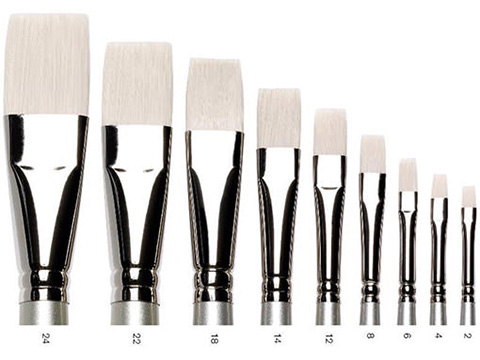
Painting technique
Lesson number three was a fundamental one: you don’t thin water-mixable paints with water just like you would with a spirit or solvent. When I mixed the Artisan paint with water an emulsion formed which was different in colour to the original paint, and nothing like the texture of regular oil paint. As the water content then evaporated the emulsion changed to an odd and slightly sticky consistency.
After reading widely on forums and in Winsor & Newton’s own marketing information (a helpful leaflet came with the boxed set) I realised that I’d somewhat misconceived the nature of water-mixable oil paints. They were never intended to be diluted with lots of water, like some sort of oily watercolour paint. The best way to think of them is as ‘water-washable’ oils, which you can rinse off your brushes between colours and clean up afterwards just with water. The benefit of WMOs is just that they are supposed to be much easier to clean, avoiding the use of solvents.
It’s fine for any water clinging to your brush after rinsing to become mixed with the paint and it’s okay to add a little drop of water to loosen the paint if you’re working with neat tube paint, personally I wouldn’t add much more than that.
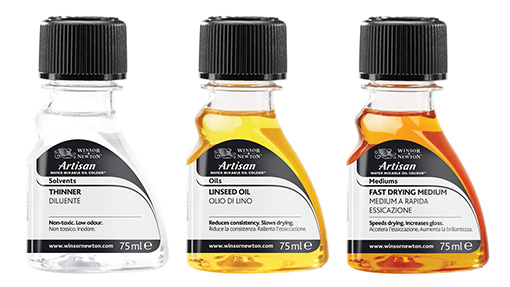
Artisan mediums. Photo credit: Jacksonsart.com
Traditionally you thin oil paint with solvents like turps or white spirit, balanced with the addition of some more oil so that the paint doesn’t become over-thinned and lose its ability to adhere to the canvas. For each layer (if working with a number of layers) you add increasing amounts of oil, following the ‘fat over lean’ principle whereby each layer contains more oil than the one below it.
Having learnt that than water wasn’t a great substitute for white spirit, I next bought some Artisan Thinner. This product does apparently still contain solvents but it is odorless. I assume it is pretty similar to the various low-odor, slow-evaporating painting mediums like Winsor & Newton’s popular ‘Sansador’. Exactly how much less toxic this is than regular spirits isn’t clear, but it certainly smells better and there isn’t a CLP warning pictogram on the label which makes me think that the solvent content must be very low. When I mixed the Artisan Thinner with the paint it started behaving much more like regular oil paint with a nice consistency and a good flow.
I think that the only place you’d ever want to add more than a drop of water to Artisan paint would be to an under layer, as it would be absorbed into the priming ground which contains plenty of oil. This would prevent it from becoming ‘unbound’. However mixing up a washy undercolour with water would give you a thin and transparent shade that would change as it dried, and so a much better option would be to mix the paint with pure Artisan Thinner, or with some Thinner and a little water mixed together.
For the upper layers I mixed the paint with some Artisan Thinner combined with a bit of oil. The Artisan range contains a wide choice of products including fast drying mediums, impasto mediums, stand oil, and a ‘Painting Medium’. All these oils have been modified to be water soluble just like the paints. There are also varnishes and varnish remover.
The Artisan paint seemed to dry slightly more slowly than regular oils because the water content first has to evaporate before the oil starts to oxidise – however you could speed this process up by using some of the fast drying oil mediums. A number of people have commented that the paint remains slightly ‘tacky’ even when touch dry and I found this to be true of Artisan, and also – surprisingly – of the Daniel Smith paint that I later tried. You’d therefore want to make sure to keep your painting free of dust whilst it dried, and possibly a varnish would eventually be necessary to stop dust sticking to it.
SOME COMMONLY ASKED QUESTIONS
Stability and archival quality
How good is the long-term, archival quality of water soluble oils? Winsor & Newton state that their testing proved the same degree of durability and stability with water-mixable oils as with their conventional oil paint. However it should be noted that although oil paint takes days or weeks to dry to the touch it takes literally decades to be fully cured, and WMOs simply haven’t been around long enough to truly be put to the test over this sort of time period.
Jacksons have stated on their blog that “A few studies have been done that tested the hardness of the paint film. In the two brands tested, the water-mixable oils were at least as durable as traditional student-grade oils like Winton, Georgian, and Van Gogh oils.” Unfortunately they don’t specify which brands they are referring to and I can’t find this study anywhere online. More studies would really be helpful because student grade ranges are less durable and stable than professional paints due to the fillers added to them, and if I were to switch to water-soluble oils I would certainly want them to have the same archival qualities as an artists’ grade range.
With water-soluble oils you still need to follow the fat over lean and thick over thin rules to ensure that your lower layers dry faster than the top layers, avoiding any cracking to the top paint film. This is a little difficult with Artisan paints, if you want to use a lot of white in an underlayer. Most good paint ranges sell an ‘Underpainting White’ paint made with linseed oil rather than the paler safflower oil, because linseed dries quicker and is therefore more suitable for underpainting. Artisan’s two white colours are both formulated with safflower oil and so Winsor & Newton advise against using Artisan’s whites for extensive use in underpainting and suggest instead using a regular non-soluble Underpainting White oil colour for underlayers. Winsor & Newton state that it’s fine to mix Artisan with regular oils, although more than just a little conventional paint in the mixture will make it no longer soluble with water.
Can you mix different brands of water mixable oils together?
Many people apparently do this successfully, although given that the various paint ranges have different methods of making the oil molecules bond with water, I’d personally be a little concerned about the future stability of the paint layers. A lot of people do use Artisan Thinner with different brands of paint without any apparent problems.
CONCLUSIONS ABOUT ARTISAN PAINTS
I wasn’t really won over to Artisan as a replacement for my regular oil paints. The main attraction of WMOs was the possibility of being able to dispense with solvents, so I was disappointed that Artisan still seemed to require the use of a solvent-containing thinner – although this would be true of any brand of water-soluble oils. If you want to use these types of paints but avoid solvents altogether you’ll need to dilute them exclusively with oil, and indeed plenty of people do work in this way, even with conventional oil paints.
The other appealing aspect of WMOs for me was the ability to clean up my paints with water, and despite the paints taking more effort than I’d expected to clean off, I did really love simply rinsing my brushes with water in between colours. I found myself still interested enough in water-mixable oils to buy some different ranges to experiment with further, and to see if I felt I could adapt to them.
EXPERIMENTS WITH OTHER RANGES
I decided to try and compare some WMO paints from the more expensive ranges, so I bought some tubes of burnt sienna from Holbein’s Duo Aqua range, Grumbacher’s Max paints, Royal Talens’ Cobra Artist range and Daniel Smith’s Water Soluble Oil Paints.
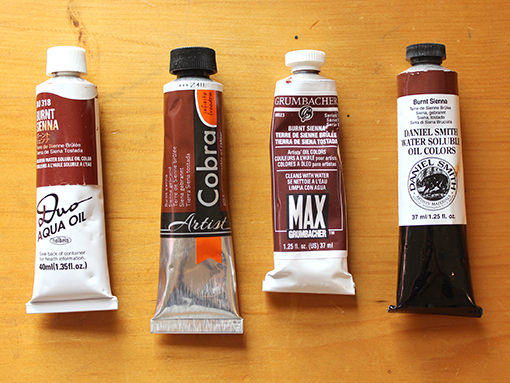
The Cobra Artists’ range which is well liked by some artists was the cheapest of the bunch. Despite the fact that its maker Royal Talens describes it as ‘artists’ grade’, it didn’t cost much more than the Artisan paints (their student range ‘Cobra Study’ is even cheaper). I found the Cobra paint more satisfactory than Artisan in terms of handling and it had a creamier texture, but the pigment load didn’t seem great.
Cobra Artists does come in a pleasingly large range of 70 colours, and half the colours are made from single pigments. There aren’t many hues apart from a couple of blue substitutes that are not correctly labelled as hues (for example there’s a ‘Cerulean Blue (Pthalo)’ which is a cerulean hue made with pthalo, and a ‘Cobalt (Ultramarine)’ which is just a cobalt hue made with ultramarine instead of true cobalt)
The Duo Aqua paint by Holbein was the biggest disappointment. It had a thin consistency but despite this was difficult to loosen with water, and it dried with a really plastic-like shine. Unlike the other brands it didn’t mix well with Artisan Thinner (although there’s no reason why it should, being a different range, and there is a Duo Aqua quick drying matte medium available so you could use this to thin the paint). The range includes 49 single-pigment colours out of a total of 83 shade. The pigment load seemed okay, although as often with Holbein the range does contain quite a lot of colours with a lower than desirable lightfastness rating.
Grumbacher’s Max range isn’t that easy to find in the UK but it has the nicest consistency being stiff and very buttery – so stiff in fact that I ended up squeezing the tube too hard to get some out and wasting a lot of paint. It took some effort to mix with water, but since I’d want to use an absolute minimum of water anyway that probably wouldn’t matter. I decided that if I were to continue experimenting with water soluble oils I would choose between the Max range and Daniel Smith’s Water Soluble Oil Paint.
I preferred the less glossy finish of the Grumbacher paint to the Daniel Smith paints which dried fairly shiny and remained quite tacky. The Max range has a good choice of 59 colours, of which 33 contain single pigments and none are hues. I noticed that all he cadmiums are ‘cadmium bariums’ which might not tint quite as strongly as regular cadmiums. However this is still better than the Daniel Smith paints which only contain very expensive cadmium hues, due to safety concerns over cadmiums which aren’t as widely shared on this side of the Atlantic. In terms of mediums the Max range is a bit disappointing with only two mediums produced to go with their WMO range: a linseed oil and an Alkyd-based fast drying oil.
Daniel Smith have a reputation for using very high pigment loads in all their paint ranges and their water soluble paints were no exception, with the colours appearing the most vivid of the ranges. I felt that whilst wet they handled in the most similar way to conventional oils. They also cleaned up considerably more easily than the Grumbacher paints. Overall both brands were pretty good but neither was perfect, and I’d want to practice a bit further before choosing one of them to work in.
© Article rights reserved. Oil portrait artist Anna Bregman
CATEGORIES
DRAWING PEOPLE
DRAWING ANIMALS
DRAWING MATERIALS
OIL PAINTING
WATERCOLOUR
PAINTING MATERIALS
FRAMING

